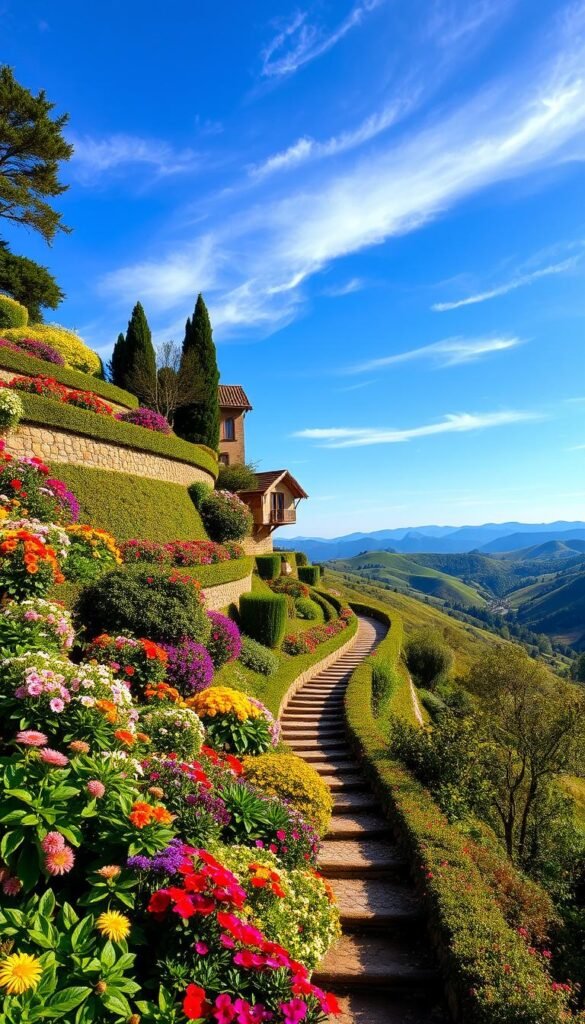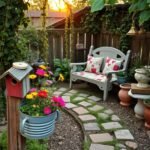Sloped yards often feel like a landscaping challenge, but they hold untapped potential for creative outdoor spaces. Terraced gardens turn steep inclines into layered planting areas that combine beauty with practicality. Imagine converting a tricky slope into a series of flat platforms where you can grow flowers, host gatherings, or unwind with a book.
These multi-level designs do more than just look good. They prevent soil erosion by slowing rainwater runoff and create microclimates for diverse plants. You might think reshaping a hill requires heavy machinery or expert help, but many projects start with simple planning and basic materials.
What makes terraced layouts special? Each level becomes its own mini-garden, letting you experiment with different themes or functions. Picture a cooking herb zone near the top, a dining area in the middle, and shade-loving ferns at the base. This approach maximizes every inch of your yard while solving drainage issues naturally.
You’ll discover how terracing can boost your property’s value and transform unused slopes into vibrant outdoor rooms. From rustic stone walls to modern raised beds, the possibilities adapt to your style and budget. Let’s explore how to turn that problematic incline into your home’s most admired feature.
Planning and Analyzing Your Multi-Level Yard
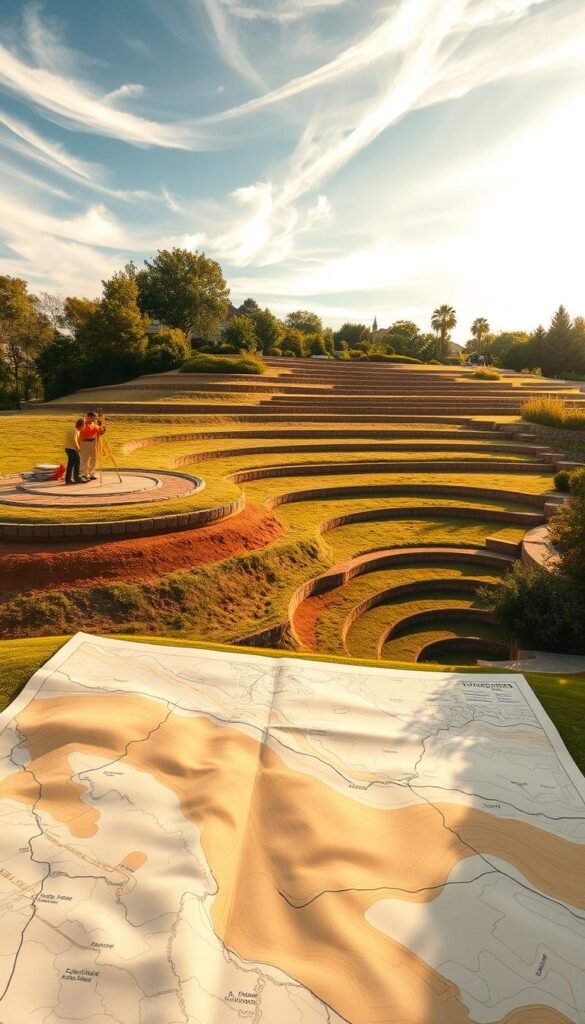
Transforming a sloped landscape starts with smart preparation. Before building your terraced oasis, assess your space thoroughly to avoid costly mistakes. Think of this phase as laying the groundwork for a design that works with your land, not against it.
Conducting a Site Analysis and Slope Assessment
Measure your slope’s steepness using a laser level or smartphone app. Steeper grades need more terraces—each acting like a stair step to manage water flow. Clay-heavy soil? You’ll want stronger retaining walls. Sandy ground? Plan for extra irrigation.
Track sunlight patterns across different levels. South-facing zones bake in summer sun, while north-facing spots stay cooler. Work around existing trees or rocks—they can become natural focal points. Always check for buried utility lines first!
Establishing Your Goals and Budget
Decide what matters most: growing veggies, creating seating areas, or elevating your space with a gardening. Stone walls cost more than timber but last decades. For tight budgets, recycled bricks or railroad ties offer charm without breaking the bank.
Leave room for pathways between levels—at least 2 feet wide for easy access. Safety matters: unstable slopes require professional input. Remember, good planning today means fewer headaches tomorrow.
Choosing the Right Materials and Structural Design
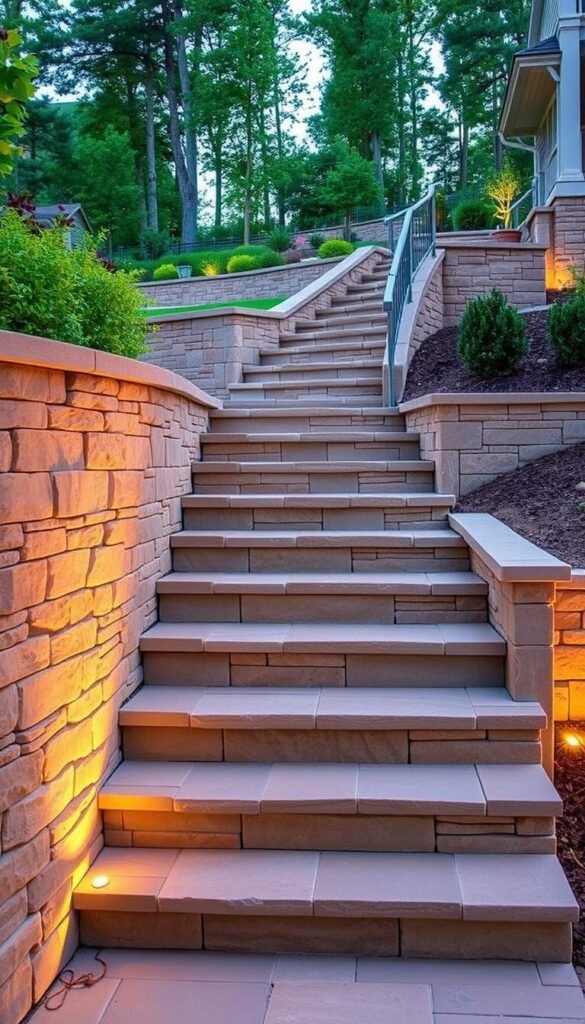
Your terraced landscape’s success starts with smart material choices and structural planning. The elements you select impact both aesthetics and functionality, creating spaces that last through seasons while reflecting your personal style.
Exploring Options for Retaining Walls and Steps
Pressure-treated timber sleepers shine for shallow slopes, offering a natural look at half the cost of brick. They blend with plantings while preventing soil shift. For taller walls, concrete blocks provide durability but consider their environmental footprint.
| Material | Cost | Durability | Eco-Friendliness |
|---|---|---|---|
| Timber Sleepers | $$ | 15+ years | Medium |
| Concrete Blocks | $$$ | 30+ years | Low |
| Natural Stone | $$$$ | Lifetime | High |
| Reclaimed Wood | $$ | 10-20 years | Highest |
Match step materials to your walls for visual harmony. Stone steps pair beautifully with dry-stack walls, while timber works well with urban green spaces. Allow 18-inch treads for comfortable climbing.
Sustainable Materials and Environmental Impact
Reclaimed bricks or locally sourced stone reduce carbon footprints while adding character. “The most eco-friendly wall is one that already exists,” notes landscape architect Mia Rodriguez. Consider permeable materials like gravel-filled gabions that manage runoff naturally.
Drainage matters as much as materials. Install perforated pipes behind walls taller than 2 feet. For severe slopes, consult an engineer—safety always comes before savings.
Stunning Terrace Garden Ideas for Multi-Level Yards
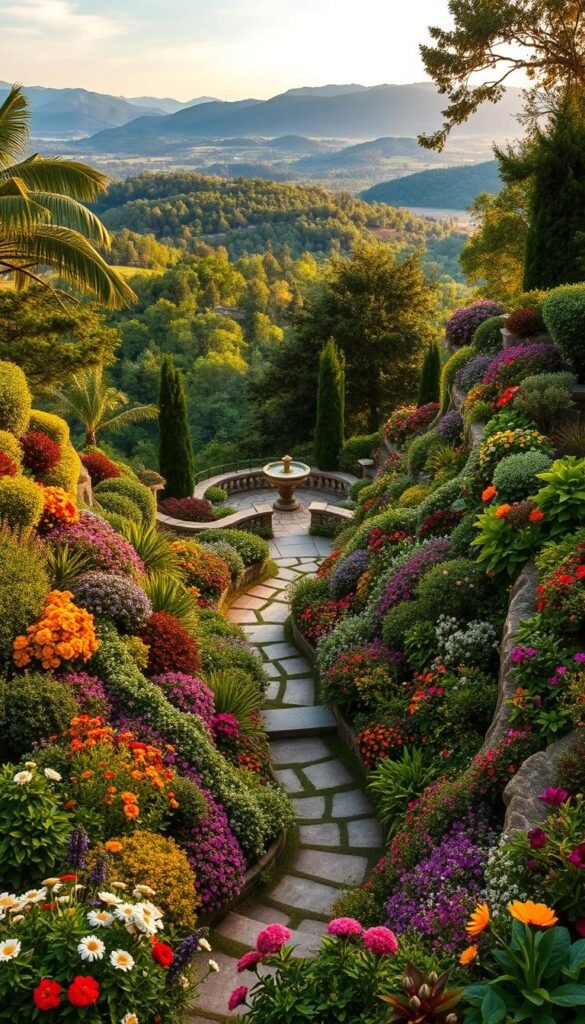
Creative zoning turns elevation changes into opportunities for personalized outdoor rooms. By assigning unique purposes to each tier, you craft a landscape that works harder while reflecting your lifestyle. Let’s explore how to blend practicality with eye-catching design elements.
Creative Concepts for Enhancing Space and Function
Designate upper tiers for sun-loving herbs or veggies, where they’ll bask in full daylight. Middle levels become perfect spots for dining areas—surround them with fragrant lavender or ornamental grasses for natural privacy. Lower terraces shaded by retaining walls? Ideal for ferns or a cozy fire pit nook.
Turn basic walls into showstoppers with these tricks:
- Embed stone planters into dry-stack walls for cascading blooms
- Install bench seating into gabion structures filled with local rocks
- Use reclaimed wood to create “bug hotels” within timber retaining walls
Sunken patios add drama to lower levels. Surround them with drought-tolerant shrubs or tall grasses that sway in the breeze. For formal appeal, mirror planters on either side of central stairs. Prefer a wilder look? Let creeping thyme spill over edges to soften stone steps.
Water features multiply your garden’s charm. A recirculating stream can trickle down slate slabs between tiers, while LED-lit fountains create evening ambiance. Pro tip: Use your slope’s natural drop to power small waterfalls without pumps.
Lighting transforms terraced spaces after sunset. Uplight textured walls to cast intriguing shadows, or line steps with solar-powered pavers. For dinner parties, hang string lights above middle terraces—they’ll make the space feel enchanted while highlighting your plantings.
Creating Dynamic Garden Beds and Planting Zones
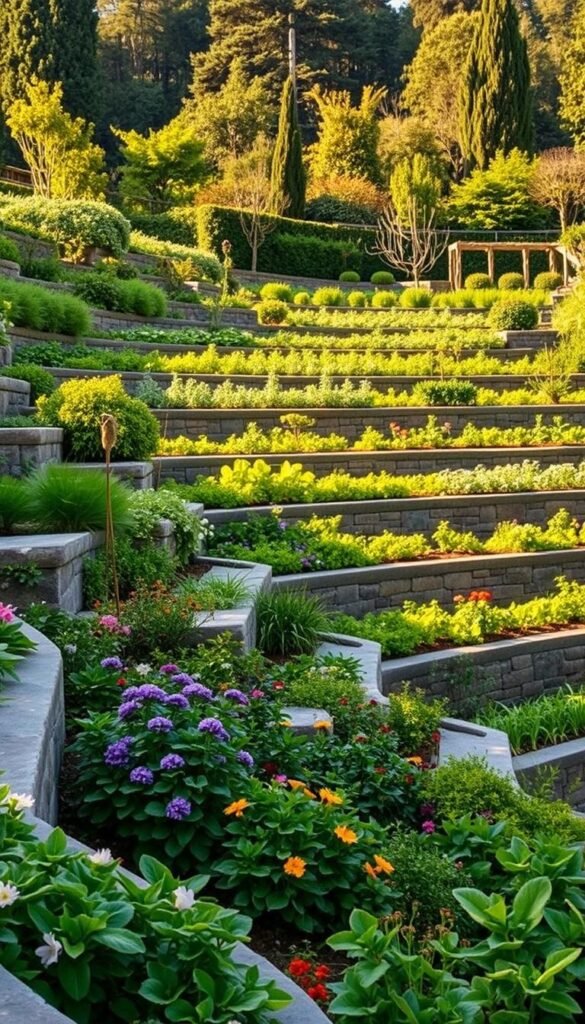
Elevation changes in your landscape create distinct growing conditions perfect for diverse planting strategies. By working with these natural variations, you can design beds that flourish while reinforcing slope stability.
Optimizing Microclimates on Different Levels
Upper tiers bake in sunlight and drain quickly—ideal spots for Mediterranean herbs like rosemary or drought-tolerant grasses. These sun-worshippers thrive where water slips through fast-draining soil. Middle levels offer balanced conditions for flowering perennials like coneflowers or black-eyed Susans.
Lower terraces collect moisture naturally. Here, hostas and astilbes drink deeply from the ground that stays damp longer. Want veggies? Try leafy greens or radishes in these cooler zones using square-foot gardening techniques for efficient layouts.
Selecting Plants that Thrive on Slopes
Choose deep-rooted species for erosion control:
- Lavender anchors soil while perfuming the air
- Daylilies spread quickly to blanket slopes
- Sedum varieties handle both drought and poor soil
Softening walls? Let creeping phlox spill over edges or train ivy along stone surfaces. For seasonal drama, mix spring bulbs with summer-blooming catmint and autumn-flowering sedum. This layered approach keeps beds lively while preventing bare patches.
Integrating Steps, Seating, and Decorative Elements
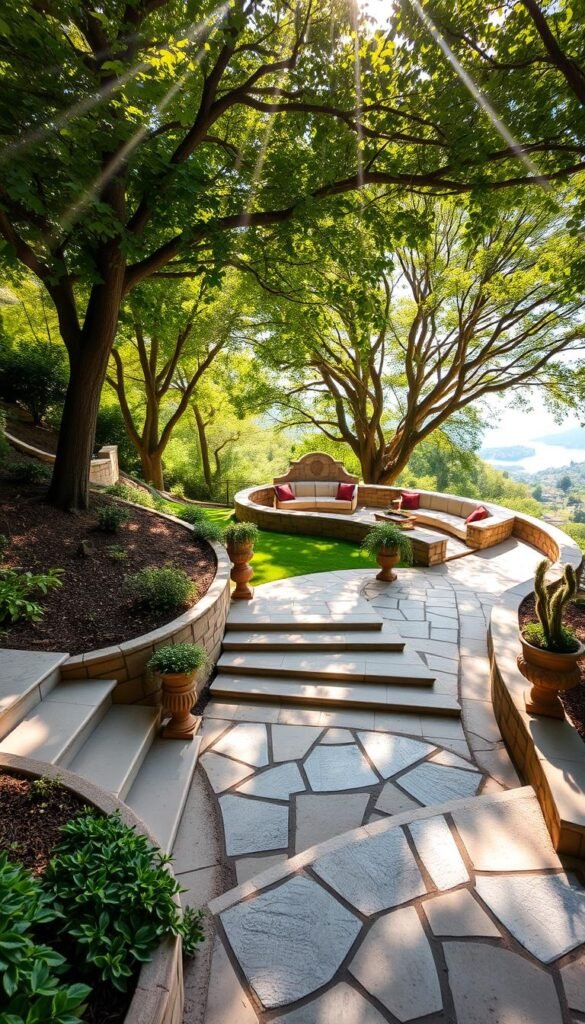
Thoughtful transitions between garden tiers transform steep slopes into inviting journeys. Steps become more than pathways—they shape how people experience your landscape. When designed well, these elements blend practicality with artistic flair, guiding visitors while highlighting your space’s best features.
Designing Steps for Easy Access and Visual Flow
Curved staircases work wonders on slopes. Gentle bends slow movement, creating natural pauses to enjoy surrounding plantings. Match materials to your walls—stone slabs pair with rugged rock faces, while timber treads complement wooden retaining structures.
Solar-powered lights along edges make night navigation safer. For extra visual interest, vary step widths or add small landings with potted plants. These breaks prevent fatigue while showcasing your fairytale vibes through seasonal blooms.
Adding Features to Enhance Aesthetic and Functionality
Built-in benches turn retaining walls into social hubs. Tuck storage under seat lids for cushions or tools. Decorative boulders placed near turns draw eyes upward, emphasizing vertical movement through the space.
Handrails don’t have to look industrial. Try twisted willow branches or powder-coated metal rods that mirror your garden’s aesthetic. These touches maintain continuity while ensuring safe passage after rain.
Implementing Effective Water Management and Drainage
Smart water control keeps your terraced spaces thriving through every season. While multi-level designs naturally slow runoff, intentional systems protect plants and structures from heavy rains or dry spells. Start by matching solutions to your slope’s unique needs.
Targeted Watering and Rain Capture
Drip irrigation delivers moisture directly to roots, cutting waste by up to 60% compared to sprinklers. Bury lines under mulch to shield them from sun damage while keeping foliage dry. Pair this with rain barrels at gutter downspouts—they’ll help store water for drier weeks.
Lower terraces often collect excess moisture. Create a rain garden here using water-loving plants like swamp milkweed or blue flag iris. These natural sponges absorb runoff while adding color and texture.
Behind every retaining wall, install perforated pipes wrapped in gravel. This drainage combo redirects water away from structures, preventing soil erosion and wall failures. For steep slopes, add extra gravel layers to stabilize the ground beneath planting beds.
With these strategies, your terraced layout becomes a self-sustaining ecosystem. Plants get consistent hydration, walls stay sturdy, and rainwater becomes a resource rather than a risk.

